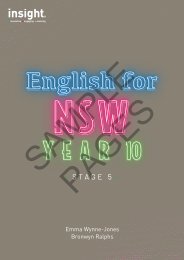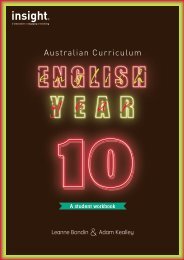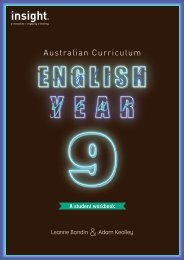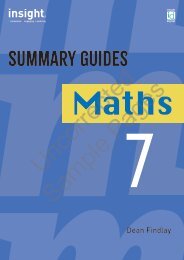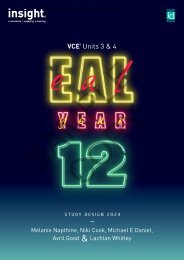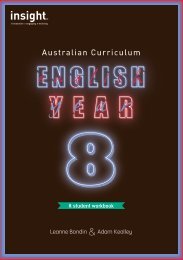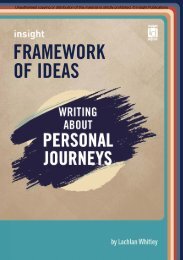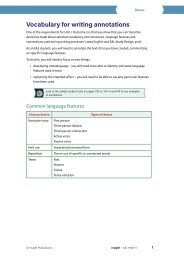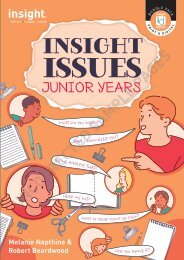Key Skills for Senior English 2nd Edition - Sample Pages
Create successful ePaper yourself
Turn your PDF publications into a flip-book with our unique Google optimized e-Paper software.
KEY<br />
SKILLS<br />
<strong>for</strong><br />
SENIOR<br />
ENGLISH<br />
Robert Beardwood, Sandra Ducanson,<br />
Melanie Napthine and Claire Warr<br />
<strong>2nd</strong> edition<br />
UNCORRECTED SAMPLE PAGES
Copyright © Insight Publications<br />
First edition published in 2016 as <strong>Key</strong> <strong>Skills</strong> <strong>for</strong> <strong>Senior</strong> <strong>English</strong>: Area of Study 1 and<br />
<strong>Key</strong> <strong>Skills</strong> <strong>for</strong> <strong>Senior</strong> <strong>English</strong>: Area of Study 2<br />
This second edition first published in 2021<br />
Insight Publications Pty Ltd<br />
3/350 Charman Road<br />
Cheltenham Victoria 3192<br />
Australia<br />
Tel: +61 3 8571 4950<br />
Fax: +61 3 8571 0257<br />
Email: books@insightpublications.com.au<br />
www.insightpublications.com.au<br />
Reproduction and communication <strong>for</strong> educational purposes:<br />
The Australian Copyright Act 1968 (the Act) allows a maximum of one chapter or<br />
10% of the pages of this work, whichever is the greater, to be reproduced and/<br />
or communicated by any educational institution <strong>for</strong> its educational purposes<br />
provided that the educational institution (or the body that administers it) has given<br />
a remuneration notice to Copyright Agency under the Act.<br />
For details of the Copyright Agency licence <strong>for</strong> educational institutions contact:<br />
Copyright Agency<br />
Tel: +61 2 9394 7600<br />
Fax: +61 2 9394 7601<br />
www.copyright.com.au<br />
Reproduction and communication <strong>for</strong> other purposes:<br />
Except as permitted under the Act (<strong>for</strong> example, any fair dealing <strong>for</strong> the purposes<br />
of study, research, criticism or review) no part of this book may be reproduced,<br />
stored in a retrieval system, or transmitted in any <strong>for</strong>m or by any means without<br />
prior written permission. All inquiries should be made to the publisher at the<br />
address above.<br />
ISBNs:<br />
9781922525277 (digital)<br />
9781922525284 (print + digital bundle)<br />
persuade<br />
UNCORRECTED SAMPLE PAGES
sent<br />
CONTENTS<br />
compare<br />
reason<br />
SECTION 01<br />
Chapter<br />
01<br />
Chapter<br />
02<br />
Chapter<br />
03<br />
Assessment summary<br />
Reading and creating texts /<br />
Reading and comparing texts<br />
Area of Study 1 overview<br />
Studying a text<br />
Text types and their features<br />
Knowing your text<br />
Characters<br />
Narrative point of view<br />
Setting and context<br />
Plot and structure<br />
Themes<br />
Values<br />
Special features of film, drama and poetry<br />
Film<br />
Drama<br />
Poetry<br />
Writing an analytical response<br />
Breaking down the topic<br />
Brainstorming ideas<br />
Developing a plan<br />
Writing your response<br />
Common mistakes<br />
Drafting and editing your response<br />
<strong>Sample</strong> response<br />
UNCORRECTED SAMPLE PAGES<br />
Insight KEY SKILLS FOR SENIOR ENGLISH 2ND EDITION iii
sent<br />
reason<br />
Chapter<br />
04<br />
Chapter<br />
05<br />
SECTION 02<br />
Chapter<br />
06<br />
Chapter<br />
07<br />
Chapter<br />
08<br />
compare<br />
Writing a creative response<br />
Approaches to the task<br />
Forms <strong>for</strong> your response<br />
The written explanation<br />
<strong>Sample</strong> response<br />
Writing a comparative response<br />
compare<br />
Preparing <strong>for</strong> reading<br />
compare<br />
persuade<br />
compare<br />
reason<br />
Identifying themes<br />
Locating similarities and differences in texts<br />
Presenting ideas through characters<br />
Writing your response<br />
<strong>Sample</strong> response<br />
Analysing and presenting argument<br />
The art of persuasion<br />
What is an issue?<br />
Understanding the news<br />
How writers persuade<br />
Context, purpose and audience<br />
Style<br />
Tone<br />
Bringing it all together: analysing a persuasive media text<br />
Understanding argument<br />
The elements of an argument<br />
Argument structure<br />
The power of language<br />
Analysing persuasive language<br />
Argument and persuasive language techniques<br />
UNCORRECTED SAMPLE PAGES<br />
iv<br />
Insight<br />
KEY SKILLS FOR SENIOR ENGLISH 2ND EDITION
persuade<br />
present<br />
sent<br />
Chapter<br />
09<br />
Chapter<br />
10<br />
Chapter<br />
11<br />
Chapter<br />
12<br />
compare<br />
Persuasive text types<br />
Headlines<br />
News articles and feature articles<br />
Opinion pieces and blog posts<br />
Editorials<br />
Letters to the editor and online comments<br />
Advertisements<br />
Speeches<br />
Petitions<br />
persuade<br />
Photographs<br />
Cartoons and illustrations<br />
Charts and graphs<br />
Filmed texts<br />
Social media, <strong>for</strong>ums and wikis<br />
Writing an analysis<br />
Texts <strong>for</strong> analysis<br />
Analysing the texts<br />
Planning your analysis<br />
Writing your analysis<br />
Editing your analysis<br />
<strong>Sample</strong> analysis<br />
Presenting your point of view<br />
Choosing an issue<br />
Planning your point-of-view piece<br />
Writing your point-of-view piece<br />
Editing your point-of-view piece<br />
Writing your statement of intention<br />
Delivering a speech<br />
The exam<br />
Exam overview<br />
Revision and preparation<br />
In the exam<br />
compare<br />
UNCORRECTED SAMPLE PAGES<br />
reason<br />
Insight KEY SKILLS FOR SENIOR ENGLISH 2ND EDITION v
ason<br />
e<br />
ade<br />
Assessment summary<br />
The table below outlines the assessment tasks and mark allocations <strong>for</strong> VCE <strong>English</strong> across<br />
Units 1 to 4. It is likely that your school will also set a mid-year exam <strong>for</strong> Unit 1 and an<br />
end-of-year exam <strong>for</strong> Unit 2.<br />
Unit 1<br />
Unit 2<br />
Unit 3<br />
Unit 4<br />
Final exam<br />
Area of Study 1<br />
Reading and creating texts /<br />
Reading and comparing texts<br />
Outcome: Produce analytical and<br />
creative responses to texts<br />
Outcome: Compare the presentation<br />
of ideas, issues and themes in two<br />
texts<br />
SAC: Produce an analytical<br />
interpretation of a selected text, AND<br />
a creative response to a different<br />
selected text<br />
Mark allocation: 60 marks (30 <strong>for</strong> each<br />
task) out of a total of 100 marks <strong>for</strong><br />
Unit 3 coursework<br />
SAC: Produce a detailed comparison<br />
that analyses how two selected texts<br />
present ideas, issues and themes<br />
Mark allocation: 60 marks out of<br />
a total of 100 marks <strong>for</strong> Unit 4<br />
coursework<br />
Section A: Write an analytical<br />
interpretation of one text<br />
Section B: Write a detailed<br />
comparative analysis of a pair of texts<br />
Mark allocation: 20 marks <strong>for</strong> each<br />
section, out of a total of 60 marks <strong>for</strong><br />
the exam<br />
Area of Study 2<br />
Analysing and presenting argument<br />
Outcome: Analyse how argument<br />
and persuasive language can position<br />
audiences, and create point-of-view<br />
texts that position audiences<br />
Outcome: Analyse how argument<br />
and persuasive language are used<br />
in texts that attempt to influence<br />
an audience, and create a text that<br />
presents a point of view<br />
SAC: Analyse and compare the use of<br />
argument and persuasive language<br />
in texts that present a point of view<br />
on an issue currently debated in the<br />
media<br />
Mark allocation: 40 marks out of<br />
a total of 100 marks <strong>for</strong> Unit 3<br />
coursework<br />
SAC: Present (in oral <strong>for</strong>m) a reasoned<br />
point of view on an issue currently<br />
debated in the media<br />
Mark allocation: 40 marks (30 <strong>for</strong><br />
the presentation + 10 <strong>for</strong> a written<br />
statement of intention) out of a total<br />
of 100 marks <strong>for</strong> Unit 3 coursework<br />
Section C: Write an analysis of how<br />
argument and language are used in an<br />
unseen text(s) to persuade others to<br />
share the point(s) of view expressed<br />
Mark allocation: 20 marks out of a<br />
total of 60 marks <strong>for</strong> the exam<br />
UNCORRECTED SAMPLE PAGES<br />
vi<br />
Insight<br />
KEY SKILLS FOR SENIOR ENGLISH 2ND EDITION
eason<br />
READING AND CREATING<br />
TEXTS / READING AND<br />
COMPARING TEXTS<br />
Area of Study 1 overview<br />
In Area of Study 1 of VCE <strong>English</strong> you will read texts selected by your<br />
school and develop analytical and creative responses to them. The<br />
responses in Units 1 and 3 are to single texts, while in Units 2 and 4<br />
you will compare the ideas, issues and themes of two texts.<br />
In this first section of <strong>Key</strong> <strong>Skills</strong> <strong>for</strong> <strong>Senior</strong> <strong>English</strong>, Chapters 1 and 2 lay<br />
the groundwork <strong>for</strong> the longer writing tasks. They show you how to<br />
study a text closely, from annotating the text and summarising key<br />
in<strong>for</strong>mation through to understanding the text’s deeper meaning.<br />
The activities will help you to improve your writing skills as well as<br />
your knowledge of a text, building from short answers requiring just<br />
a few words to short paragraphs on a particular feature or theme.<br />
The responses you will produce to single texts take two different<br />
<strong>for</strong>ms: analytical and creative. Chapters 3 and 4 explain the<br />
requirements of each kind of response and how you can approach<br />
and improve your skills in each task.<br />
In Units 2 and 4 you will write comparative analyses of a pair of<br />
texts – one pair in Unit 2, and a different pair in Unit 4. This involves<br />
many of the same skills as responding to a single text, but with the<br />
additional skills of comparing and contrasting the two texts.<br />
Chapter 5 gives you some key strategies <strong>for</strong> comparing texts as well<br />
as <strong>for</strong> writing a coherent, well-structured comparative essay.<br />
compare<br />
UNCORRECTED SAMPLE PAGES<br />
Insight KEY SKILLS FOR SENIOR ENGLISH 2ND EDITION 1
t<br />
eason<br />
re<br />
uade<br />
STUDYING<br />
A TEXT<br />
In this chapter<br />
❱ Text types and their features<br />
❱ Knowing your text<br />
❱ Characters<br />
❱ Narrative point of view<br />
❱ Setting and context<br />
❱ Plot and structure<br />
❱ Themes<br />
❱ Values<br />
Whether you are writing an analytical response or a creative<br />
response, you need to know your text thoroughly and develop<br />
your own understanding of what the text means and what<br />
its creator is trying to convey to readers. You will think about<br />
the decisions made by the author in relation to the characters,<br />
setting, narrator, plot, language choices and the wider themes<br />
and ideas that the text explores.<br />
This chapter guides you through the essential elements of texts<br />
that you need to know and write about. Use the activities to<br />
identify these elements in your own texts and to build your<br />
confidence and skills in writing about them.<br />
Chapter<br />
01<br />
UNCORRECTED SAMPLE PAGES<br />
2<br />
Insight<br />
KEY SKILLS FOR SENIOR ENGLISH 2ND EDITION
Characters<br />
Characters drive the narrative. Usually it is the characters’ experiences that initially engage<br />
our attention. Then, as we read, we build up a relationship with the characters that keeps<br />
us reading to find out what happens to them.<br />
When we analyse a text, we go beyond ‘what happens’ to the characters to study how the<br />
writer explores key ideas and issues through the characters’ actions and reactions. We<br />
learn about a character in four main ways, outlined below. Give examples about the main<br />
character in your own text in the spaces.<br />
• What the character says<br />
• What the character does<br />
• What other characters say about him or her<br />
• What the narrator says about the character<br />
Main and minor characters<br />
A text’s plot revolves around the main characters. A central main character<br />
is sometimes called the protagonist. Main characters are almost always rounded<br />
characters – they are complex, with both positive and negative qualities, just like real<br />
people. They usually develop or change over the course of the text.<br />
Minor characters are less complex than main characters. In addition to helping to move<br />
the plot <strong>for</strong>ward, minor characters can serve several functions, including:<br />
• helping the main character<br />
• holding opposing views to the main character<br />
• showing qualities that are intended to gain the audience’s approval<br />
• showing qualities that are intended to gain the audience’s disapproval<br />
• giving background in<strong>for</strong>mation on the main character<br />
Studying a text Chapter 1<br />
UNCORRECTED SAMPLE PAGES<br />
ade<br />
ason<br />
e<br />
• acting as someone to whom the main character can tell their inner thoughts and<br />
feelings.<br />
t<br />
Insight KEY SKILLS FOR SENIOR ENGLISH 2ND EDITION 3
ason<br />
e<br />
ade<br />
Chapter 8 Studying a text<br />
What do you need to know about characters?<br />
Complete the table below with key in<strong>for</strong>mation about three characters from your own text.<br />
Main character 1 Main character 2 Minor character<br />
Personal details – their<br />
full name, their age and<br />
where they live<br />
Character and personality<br />
– their strengths,<br />
weaknesses and significant<br />
traits<br />
Background – their<br />
families; their social and<br />
cultural context<br />
Motivations – why do they<br />
act in certain ways and<br />
make the choices they do?<br />
Relationships – with other<br />
characters and with their<br />
surroundings<br />
Changes – in their<br />
character, relationships,<br />
circumstances or attitudes<br />
Word bank <strong>for</strong> characters<br />
The left column of the table below lists some common words used to describe characters.<br />
To add interest and precision to your writing on texts, try describing characters using some<br />
of the words in the columns on the right instead of the more common words. Fill in the<br />
blank spaces with words of your own.<br />
Common word<br />
More specific words with similar meanings<br />
strong domineering powerful resilient<br />
weak passive submissive subservient<br />
good honourable noble virtuous<br />
bad corrupt immoral malevolent<br />
kind compassionate humane sympathetic<br />
nasty cruel heinous malicious<br />
quiet introverted reserved reticent<br />
UNCORRECTED SAMPLE PAGES<br />
loud belligerent boisterous extroverted<br />
4<br />
Insight<br />
KEY SKILLS FOR SENIOR ENGLISH 2ND EDITION
t<br />
Common word<br />
More specific words with similar meanings<br />
Studying a text<br />
Chapter 1<br />
ason<br />
honest frank genuine trustworthy<br />
dishonest deceptive duplicitous manipulative<br />
loyal committed devoted steadfast<br />
disloyal faithless treacherous treasonous<br />
greedy avaricious self-indulgent self-seeking<br />
generous benevolent magnanimous selfless<br />
smart ingenious intelligent perceptive<br />
silly naive unintelligent unwise<br />
rash impetuous impulsive reckless<br />
careful cautious circumspect guarded<br />
brave courageous fearless intrepid<br />
frightened cowardly fearful timid<br />
thoughtful contemplative reflective meditative<br />
practical pragmatic expedient realistic<br />
Write about characters<br />
1. Work in pairs. Take it in turns to play the role of the interviewer and of a character<br />
in your text. (Instead of a character it could be the subject of your nonfiction text<br />
or the speaker of a poem.) The interviewer should ask the interviewee between<br />
five and ten interesting open questions. (An open question is one that requires<br />
more than a short, factual answer.) The interviewee’s responses should be as<br />
detailed and thoughtful as possible.<br />
2. Complete the table on the following page <strong>for</strong> the protagonist (main character) of<br />
one of your selected texts.<br />
• Choose three words from the word bank on pages 4–5 that apply to the<br />
protagonist and write them in the left-hand column of the table.<br />
• In the middle column, write an action or thought of the character that supports<br />
each descriptor.<br />
• In the right-hand column, write an appropriate quotation <strong>for</strong> each thought or<br />
action.<br />
Repeat the process <strong>for</strong> other important characters in the text. An example has<br />
UNCORRECTED SAMPLE PAGES<br />
been done <strong>for</strong> you.<br />
ade<br />
e<br />
Insight KEY SKILLS FOR SENIOR ENGLISH 2ND EDITION 5
ason<br />
Chapter 8<br />
Studying a text<br />
Protagonist’s name: Eve Harrington (All About Eve)<br />
Descriptors Character’s thoughts and actions Quotations<br />
e<br />
ade<br />
deceitful<br />
ambitious<br />
ruthless<br />
Protagonist’s name:<br />
Eve changes her name from<br />
Gertrude Slescynski and invents a<br />
new identity.<br />
She mimics Margo’s behaviour in<br />
order to become as successful as<br />
Margo.<br />
She blackmails Karen in order to get<br />
the part of Cora.<br />
Descriptors Character’s thoughts and actions Quotations<br />
‘I’ve always considered myself a very<br />
clever girl – smart, good head on my<br />
shoulders.’<br />
Eve studies Margo, as if she ‘was a<br />
play or a book or a set of blueprints<br />
– how you walk, talk, eat, think,<br />
sleep.’<br />
‘Imagine: to know every night that<br />
different hundreds of people love<br />
you … They want you. You belong.<br />
Just that alone is worth anything!’<br />
3. Identify three important actions or behaviours of one character and write them in<br />
the left-hand column below. An example has been done <strong>for</strong> you.<br />
Action/Behaviour<br />
Tilly finds happiness and satisfaction in<br />
making beautiful dresses <strong>for</strong> the women of<br />
Dungatar. (The Dressmaker)<br />
Attributes<br />
talented, creative, generous<br />
UNCORRECTED SAMPLE PAGES<br />
4. What qualities are revealed by each of these actions? Look back to your word<br />
bank of useful descriptors on pages 4–5, and write the attributes next to the<br />
actions in the right-hand column above.<br />
6<br />
Insight<br />
KEY SKILLS FOR SENIOR ENGLISH 2ND EDITION
eason<br />
are<br />
suade<br />
WRITING AN<br />
ANALYTICAL<br />
RESPONSE<br />
In this chapter<br />
❱ Breaking down the topic<br />
❱ Brainstorming ideas<br />
❱ Developing a plan<br />
❱ Writing your response<br />
❱ Drafting and editing your response<br />
❱ Common mistakes<br />
❱ <strong>Sample</strong> response<br />
An analytical text response is a <strong>for</strong>mal essay in which you show<br />
your knowledge and understanding of a text. It nearly always<br />
responds to a topic or question about the text, and your essay<br />
will present your point of view on the topic – that is, it will argue<br />
a case.<br />
This chapter leads you through the process of writing an essay<br />
on a given topic. The steps in this process are:<br />
• analysing the topic<br />
• brainstorming ideas<br />
• developing a plan<br />
• writing the essay in three parts: introduction, body<br />
paragraphs, conclusion<br />
• editing and rewriting your essay.<br />
Chapter<br />
03<br />
UNCORRECTED SAMPLE PAGES<br />
ent<br />
Insight KEY SKILLS FOR SENIOR ENGLISH 2ND EDITION 7
ason<br />
e<br />
ade<br />
Chapter 3 Writing an analytical response<br />
Writing your response<br />
This section explains how to develop each section of your essay – introduction, body<br />
paragraphs and conclusion.<br />
Introductions<br />
An introduction lets your reader know what lies ahead. It should provide a clear response<br />
to the topic and give your reader clues about the direction the response will take.<br />
Your introduction should include:<br />
• your main contention – a clear and concise statement of your<br />
position in response to the topic<br />
• essential in<strong>for</strong>mation about the text – its title and author/<br />
creator; possibly its <strong>for</strong>m or genre (e.g. novel, play, film); possibly<br />
some contextual in<strong>for</strong>mation (e.g. about setting)<br />
• key terms from the topic, as well as any key concepts you<br />
introduce as part of your argument<br />
• signposts to what you will discuss in the body paragraphs – the<br />
main reasons and brief references to the evidence you will use<br />
(e.g. characters, events, stories, poems or scenes to be analysed).<br />
Study the following sample introductions.<br />
Example 1: A simple introduction<br />
Text: Nine Days by Toni Jordan<br />
Topic: ‘The characters in Nine Days have limited choices in life.’ Do you agree?<br />
Toni Jordan’s Nine Days describes key events in the lives of the<br />
Westaway family over several decades from the 1940s through<br />
to the early twenty-first century. 1 The characters face choices<br />
and make decisions that shape their futures, in some cases with<br />
tragic consequences. 2 Yet their options are limited by hardship<br />
and by social expectations, meaning they have few choices<br />
available to them. 3<br />
TIP: In the introduction,<br />
keep the emphasis on<br />
your argument; avoid<br />
using detailed evidence.<br />
1 Introduces text details and<br />
provides the historical context.<br />
2 Addresses the topic using the<br />
key term ‘choices’.<br />
rite<br />
3 Responds to the topic with a<br />
main contention; includes two<br />
general signposts: ‘hardship’ and<br />
‘social expectations’.<br />
This topic asks a direct question – the introduction must answer it. In this case, the<br />
contention is a straight<strong>for</strong>ward ‘yes, the characters’ choices are limited’. The contention<br />
also offers a sense of what limits those choices – financial hardship and social expectations<br />
– suggesting that these two issues will be discussed in the body paragraphs.<br />
comp<br />
UNCORRECTED SAMPLE PAGES<br />
per<br />
8<br />
Insight<br />
KEY SKILLS FOR SENIOR ENGLISH 2ND EDITION<br />
pres
eason<br />
are<br />
suade<br />
THE ART OF<br />
PERSUASION<br />
In this chapter<br />
❱ What is an issue?<br />
❱ Understanding the news<br />
❱ How writers persuade<br />
❱ Context, purpose and audience<br />
❱ Style<br />
❱ Tone<br />
❱ Bringing it all together: analysing a persuasive media text<br />
How many people try to persuade you during the course of a day?<br />
Even be<strong>for</strong>e you leave the house, an advertisement may have<br />
encouraged you to buy something, a family member may have<br />
convinced you to eat a better breakfast and a friend’s Instagram post<br />
may have influenced you to follow a particular hashtag. News media<br />
– including newspapers, blogs, and social media posts – is also a part<br />
of our daily lives and constantly positioning us, whether we are aware<br />
of it or not, to view people, events and issues in particular ways. Being<br />
able to deconstruct, or take apart, the basic elements of another<br />
person’s point of view can help you to decide whether or not you<br />
agree with them.<br />
This chapter sets out the basic vocabulary and knowledge required to<br />
start analysing persuasive language and argument. It will help you to:<br />
• identify issues<br />
• understand how the news is produced and presented<br />
Chapter<br />
06<br />
UNCORRECTED SAMPLE PAGES<br />
• understand methods of persuasion<br />
• recognise the importance of context, purpose and audience<br />
ent<br />
• identify and describe style and tone.<br />
Insight KEY SKILLS FOR SENIOR ENGLISH 2ND EDITION 9
ason<br />
e<br />
ade<br />
Chapter 6 The art of persuasion<br />
Tone<br />
Tone is the mood or feeling of a text; it reflects a writer’s attitude to a topic or issue. Often,<br />
a writer will establish a different tone to support – or oppose – different arguments and<br />
points of view in their text. For example, a writer may begin a letter with a relieved tone<br />
when discussing the ef<strong>for</strong>ts of the police to catch a criminal, and switch to an angry tone<br />
when describing rising crime rates. To identify a writer’s tone, it is helpful to read the text<br />
aloud to reveal the emotions or attitudes underlying their words.<br />
To identify tone, consider the feeling evoked by specific words and phrases.<br />
Clearly this inspired development is essential to building community spirit.<br />
The highlighted words in the sentence above contribute to a positive, uplifting tone.<br />
This monstrous blight on the local landscape must be prevented.<br />
Here the highlighted words contribute to a<br />
tone.<br />
Add your own positive, neutral and negative words to the tone word bank below. Try<br />
to find words that cover a range of tones. For example, appreciative is the opposite of<br />
disparaging and measured lies somewhere in the middle of the two.<br />
Positive Neutral Negative<br />
appreciative measured disparaging<br />
assured matter-of-fact uncertain<br />
conciliatory composed provocative<br />
dynamic responsible sluggish<br />
enthusiastic careful apathetic<br />
optimistic restrained pessimistic<br />
UNCORRECTED SAMPLE PAGES<br />
Consider this extract from an opinion piece arguing that children should not be given gift<br />
cards as presents.<br />
10<br />
Insight<br />
KEY SKILLS FOR SENIOR ENGLISH 2ND EDITION
The art of persuasion<br />
Chapter 6<br />
Young children are faced with a bombardment of advertising that deliberately and<br />
sneakily targets their weak spots and capitalises on their naivety. They simply do not<br />
have the necessary critical thinking skills to understand and assess how advertisers are<br />
manipulating them. Nor do they have the maturity or financial experience to manage<br />
their own ‘credit’, which is what gift cards essentially are. This makes them a particularly<br />
vulnerable group who should not be asked to take on the complex responsibility<br />
required by gift cards.<br />
Find an important word or phrase associated with the following nouns. Then complete the<br />
sentences to describe the tone that these descriptions create. An example has been done<br />
<strong>for</strong> you.<br />
children: vulnerable<br />
The word ‘vulnerable’ suggests that young children are likely to suffer harm from being<br />
given gift cards and thus need protection. This word choice helps to create a concerned<br />
tone.<br />
advertising:<br />
The word/phrase<br />
This helps to create a/an<br />
gift cards:<br />
The word/phrase<br />
This helps to create a/an<br />
tone.<br />
implies that<br />
tone.<br />
has connotations of<br />
Bringing it all together: analysing a persuasive<br />
media text<br />
The following opinion piece by Patrick Carlyon was published in the Herald Sun newspaper.<br />
Read the piece, then answer the questions that follow.<br />
The need <strong>for</strong> bike controls is plain<br />
Bike people don’t like the idea of bike speed limits<br />
at Southbank. It seems unfair, they say. Yet it<br />
sounds like a wonderful initiative to the rest of us.<br />
Here comes Mr Fancy Pants. Indigenous to<br />
Southbank promenade, he sports more bits than a<br />
camping trip, and more bulges than an overpacked<br />
plastic bag.<br />
He weaves through the masses on a bike as if he<br />
is dodging bogeys in a video game. His expression<br />
is grim. He has somewhere to be, and never mind<br />
the startled glares.<br />
Mr Fancy Pants is also indigenous to walking<br />
paths, such as Darebin Creek Trail, where he scans<br />
the obstacles ahead like Terminator in a bikie bar.<br />
Without warning, he whirrs through scooters,<br />
dogs, wheelchairs and wayward toddlers, be<strong>for</strong>e<br />
surging <strong>for</strong> the 29m of open path ahead.<br />
Bike people don’t like the idea of bike speed<br />
limits at Southbank. It seems unfair, they say,<br />
especially because bikes don’t boast speedometers.<br />
UNCORRECTED SAMPLE PAGES<br />
ade<br />
ason<br />
e<br />
t<br />
Insight KEY SKILLS FOR SENIOR ENGLISH 2ND EDITION 11
ason<br />
e<br />
ade<br />
Chapter 6<br />
The art of persuasion<br />
Traffic is minimal during the hibernation of<br />
COVID. Why now, they argue? Why fines of<br />
$1652?<br />
Yet it sounds like a wonderful initiative to the<br />
rest of us.<br />
The need <strong>for</strong> bike controls is plain. A 2019<br />
study found nine in 10 cyclists rode at more than<br />
15km/h on the promenade.<br />
Any hapless commuter who crosses the strip to<br />
and from Flinders Street Station does not need a<br />
study to describe the risks.<br />
<strong>Senior</strong> Constable Craig Johnson on the radar.<br />
Picture: Mark Stewart<br />
They must navigate not only entitled male<br />
cyclists, and their heinous crimes against fashion,<br />
but also the courier cyclist, known as Mr Antsy<br />
Pants.<br />
A kind of feral replicate of Mr Fancy Pants, he<br />
pedals as if he is delivering urgent organs <strong>for</strong> surgery.<br />
Mr Antsy Pants’ self-importance defies his pay<br />
cheque, which apparently does not cover the cost<br />
of deodorant.<br />
What surveys and studies do not measure<br />
is how speeding cyclists scare the bejesus out of<br />
walkers.<br />
Bike enthusiasts wave findings that show<br />
pedestrian collisions have not risen.<br />
There is an awful lot of literature about cyclists,<br />
their aggression or lack of it, and the imperative<br />
to promote respect between cyclists, drivers and<br />
pedestrians.<br />
As cyclists are vulnerable to cars, so pedestrians<br />
are vulnerable to cyclists. Where driver education<br />
has softened views on cyclists, cyclist education<br />
should explore the attitudes of pedestrians going<br />
about their everyday business.<br />
What the research has so far not measured is<br />
the sudden jolt of playing chicken with a speeding<br />
cyclist. Do you go left, right, or stand still and hope?<br />
The perception of risk is not only frustrating,<br />
but also perpetuates the historical disdain <strong>for</strong><br />
cyclists and their perceived sense of entitlement.<br />
Most cyclists, like most car drivers, are not<br />
menaces. Any reasonable driver does not begrudge<br />
their place on the roads or tracks. Not the mothers<br />
with kids strapped on the back. Or dads who have<br />
nothing to prove to themselves.<br />
These benign breeds tinkle pedestrians ahead<br />
and slow accordingly. They would heed promenade<br />
speed limits, mindful that they are only elements<br />
in an environment which is not the final stage of<br />
the Tour de France.<br />
They are not the reason non-cyclists instinctively<br />
reject cyclist grievances. This reflex is a<br />
response to Mr Fancy Pants who, apart from<br />
speeding, should be held to account <strong>for</strong> other<br />
breaches of the greater good.<br />
Why stop with speed limits at Southbank?<br />
Police with speed guns would be a welcome addition<br />
at Darebin Creek Trail. There are lots of<br />
bushes to hide behind.<br />
What of the unchecked herds of Mr Fancy<br />
Pants who assume weekend control of Beach<br />
Road because their group jaunt is more important<br />
than the kilometre of cars banked behind them?<br />
These blokes, and they always seem to be blokes,<br />
represent a cycling subset.<br />
Their specialty is myopic self-interest. The<br />
law about two cyclists abreast does not apply to<br />
them. Two serious accidents, including the death<br />
of a pedestrian, have involved cyclists running red<br />
lights.<br />
Their outings take precedence over the ordinary<br />
people who wonder why the men don’t take their<br />
peloton pretensions to places where they need not<br />
dodge drivers cased in 1.5 tonnes of metal.<br />
To borrow a line, they are as much a danger to<br />
themselves as to the eyes.<br />
They appear to inhabit a world where “PBs” are<br />
an ice breaker. Their chatter, usually over a croissant<br />
at the cafe they choose to invade at ride’s end,<br />
sounds a lot like golfers who prattle about their<br />
rounds.<br />
These may be gross generalisations. But if they<br />
are to be unpicked, road laws should apply to the<br />
cycle clowns who hijack the peace and progress of<br />
so many.<br />
Punish them <strong>for</strong> their smug lack of consideration.<br />
To do so would bring greater harmony and<br />
care from all.<br />
After all, Mr Fancy Pants is why so many<br />
non-cyclists still dislike cyclists.<br />
UNCORRECTED SAMPLE PAGES<br />
Patrick Carlyon is a Herald Sun columnist<br />
12<br />
Insight<br />
KEY SKILLS FOR SENIOR ENGLISH 2ND EDITION
t<br />
Analyse a media text<br />
The art of persuasion<br />
Chapter 6<br />
ason<br />
Complete the following sentences to analyse Carlyon’s opinion piece.<br />
The issue addressed in the opinion piece is<br />
Patrick Carlyon’s main contention is<br />
Two possible factors that might affect his opinion are<br />
and<br />
The purpose of the opinion piece is to<br />
The target audience of the opinion piece is<br />
The opinion piece aims to make the audience feel<br />
The opinion piece aims to make the audience think<br />
One method of persuasion used by Carlyon is<br />
This is evident, <strong>for</strong> example, when he<br />
Another method of persuasion used by Carlyon is<br />
This occurs when he<br />
The style of the opinion piece could be described as<br />
The main register Carlyon writes in is<br />
that demonstrate this are<br />
The main tone of the piece is<br />
Two words/phrases that help to create this tone are<br />
Two words or phrases<br />
UNCORRECTED SAMPLE PAGES<br />
and<br />
ade<br />
e<br />
Insight KEY SKILLS FOR SENIOR ENGLISH 2ND EDITION 13



